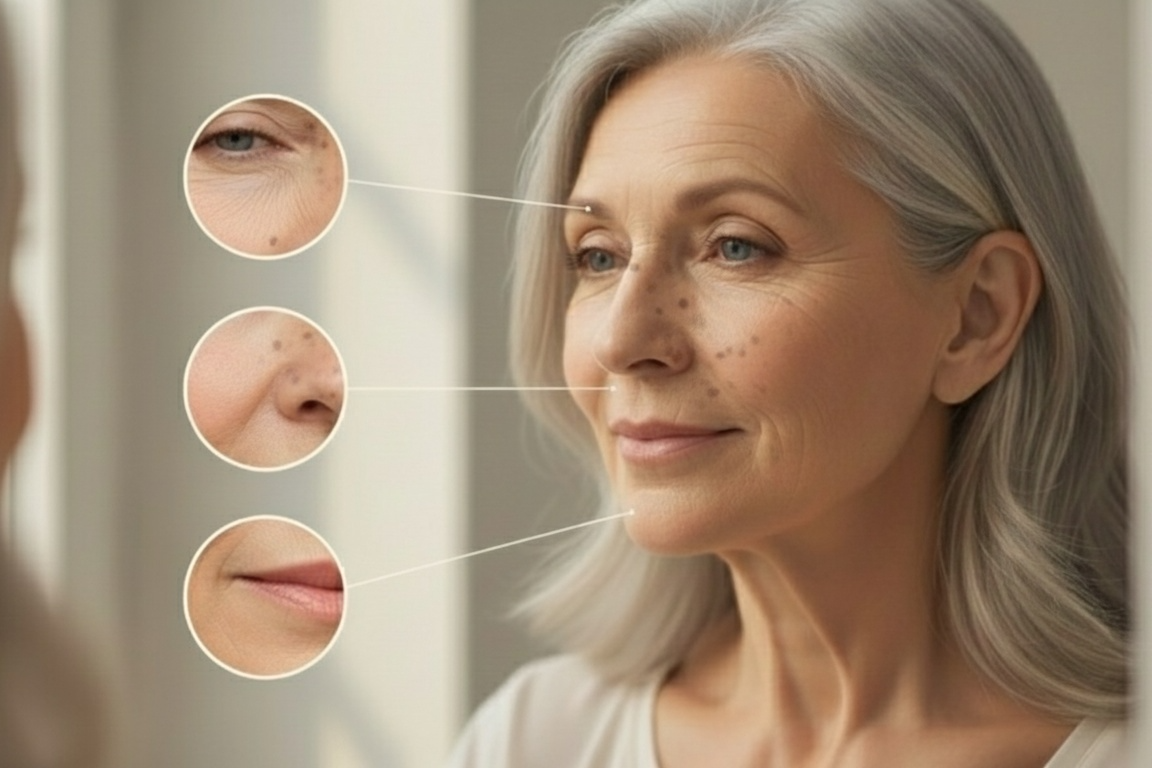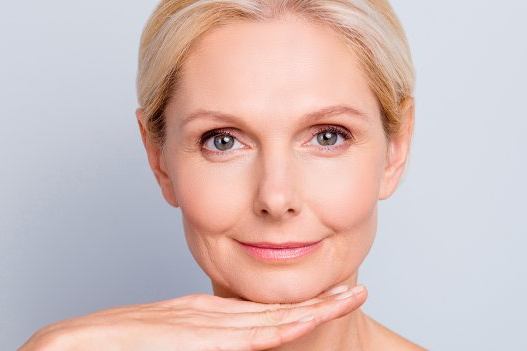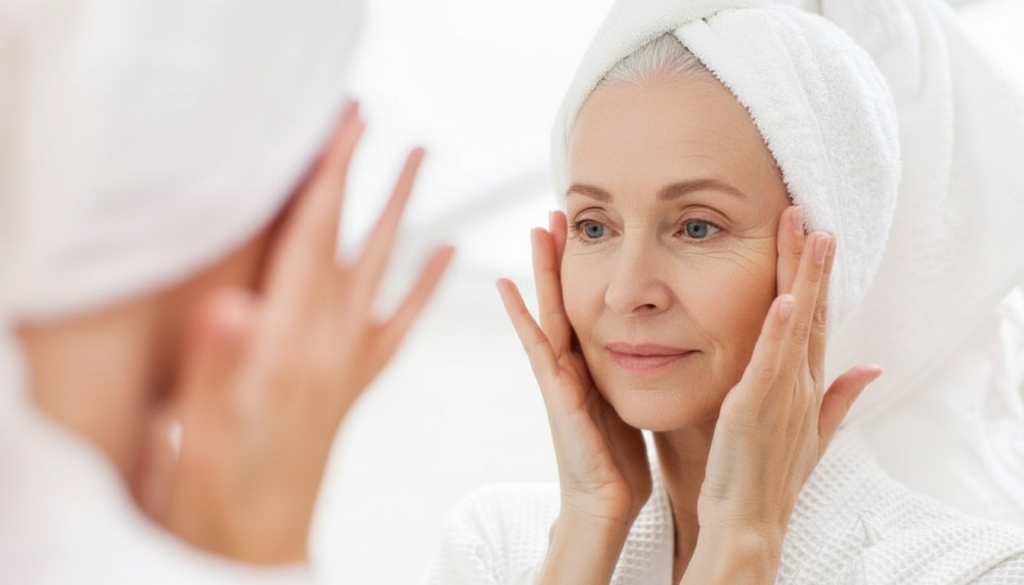The anti-ageing cosmetics segment is positioned as one of the most profitable and competitive areas within skincare by 2025. With consumers increasingly informed, discerning, and willing to invest in highly effective products, brands seeking to stand out must go beyond superficial marketing: they need to deliver tangible results, functional ingredients, and verifiable scientific backing.
It’s no longer just about “reducing wrinkles”. The new approach considers the prevention, correction, and regeneration of signs of ageing from a holistic perspective. This entails developing a premium skincare line with advanced technology, sensorial textures, and clinical studies to support every claim.
In this context, working with a specialised OEM/ODM laboratory is key to achieving genuine differentiation. Their role extends far beyond manufacturing, encompassing the entire innovation process: from selecting star active ingredients to final formulation, packaging, and regulatory support.
Throughout this article, we will analyse how to develop a strong value proposition in anti-ageing, which ingredients make the difference, how to build a premium narrative without losing accessibility, and why choosing an OEM/ODM partner can accelerate your commercial success.
1- Star Ingredients in Anti-Ageing Cosmetics
The heart of any effective anti-ageing line lies in its active ingredients. Today’s consumer is no longer satisfied with generic claims; they seek to understand what each component does, how it acts on the skin, and what results they can expect.
Biomimetic Peptides
Biomimetic peptides are short chains of amino acids designed to mimic the skin’s natural processes, such as the production of collagen, elastin, or hyaluronic acid. These actives function as “cellular messengers”, sending specific signals that stimulate skin regeneration.
- They stimulate type I and III collagen synthesis
- They improve skin firmness and elasticity
- They visibly reduce fine lines and wrinkles with continued use
- They are well tolerated, even by sensitive skin
Example: hexapeptide-8 (a topical alternative to Botox) reduces superficial muscle contractions responsible for expression lines.
Retinoids
Retinoids (vitamin A derivatives) remain the most scientifically substantiated actives in anti-ageing. They work by accelerating cell turnover, promoting collagen production, and regulating melanocyte activity (pigment-producing cells).
- They slow chronological and photo-induced ageing
- They reduce wrinkles, enlarged pores, and dark spots
- They improve overall skin texture and tone
There are different generations: retinol, retinal, retinyl palmitate, and the most potent such as retinoic acid (the latter for medical use). Current innovation focuses on encapsulation systems that minimise irritation and maximise efficacy.
Hyaluronic Acid
Hyaluronic acid (HA) is a polysaccharide naturally present in the dermis, essential for maintaining skin hydration and structure. In cosmetics, it is used in different molecular forms:
- High molecular weight HA: hydrates the surface and improves elasticity
- Low molecular weight HA: penetrates deeper layers, creating a plumping effect
- Cross-linked HA: forms a more stable network with prolonged action
This active delivers an immediate plumping and refreshing effect, ideal for enhancing the sensorial experience and the perception of results from the first use.
Antioxidants and Growth Factors
Antioxidants such as vitamin C, vitamin E, niacinamide, resveratrol, and coenzyme Q10 neutralise free radicals, protect against oxidative damage, and improve skin radiance.
Meanwhile, growth factors (such as EGF – epidermal growth factor) stimulate cellular regeneration at the epidermal level, improving skin density and accelerating repair processes.
These actives, used in synergy, enable the design of multi-layered, multifunctional formulas that not only treat visible symptoms, but also act on the causes of skin ageing.
The Value of Synergy and Scientific Validation
An effective formula is not based on a single star ingredient, but on the intelligent combination of actives that work in synergy. This requires in-depth understanding of:
- Compatible mechanisms of action
- Stable chemical interactions
- Optimal and safe concentrations
- Delivery systems that ensure bioavailability of the actives
Furthermore, in vitro and in vivo efficacy testing and clinical studies with volunteers are essential tools to support claims such as:
- “Visibly reduces wrinkles in 28 days”
- “Improves firmness and elasticity by 35%”
- “Increases skin hydration by up to 70% after 1 hour”
The OEM/ODM laboratory plays a key role at this stage, providing testing methodologies, scientific validation, and solid sales arguments to position your premium line in the market.
2. Preventive, Corrective, and Regenerative Skincare

To stand out with an anti-ageing skincare line, it is essential to understand that not all consumers are looking for the same thing. Skin ageing does not occur in a linear or uniform manner, so segmenting the offering according to different stages of the ageing process allows you to personalise the proposition and attract diverse audiences.
Preventive Skincare: Anticipating the First Signs
This targets a young-adult audience (25–35 years) who do not yet show pronounced wrinkles but want to prevent premature ageing.
This group particularly values:
- Light textures and fast-absorbing formulas
- Ingredients with antioxidant and protective action
- Claims such as “first lines”, “radiance”, or “urban defence”
Key actives include:
- Stabilised vitamin C, to even skin tone and protect against oxidative stress
- Niacinamide, to strengthen the skin barrier
- Low molecular weight hyaluronic acid, to maintain natural hydration
- Adaptogenic botanical extracts, such as ginseng or centella asiatica, which help the skin resist environmental stress
Communication should focus on conscious prevention, self-care as a routine, and the idea that “starting earlier means caring better.”
Corrective Cosmetics: Treating Visible Signs
This segment represents the heart of the anti-ageing market. It targets people aged 35 to 55 who present visible signs such as:
- Marked expression lines
- Loss of firmness and elasticity
- Pigmentation spots or uneven tone
- Rough texture or enlarged pores
Here, products must offer visible effects in the short and medium term, which involves working with highly effective actives and validated claims.
Key actives:
- Encapsulated retinoids: restructure the skin from deep layers
- Biomimetic peptides: increase dermal density and improve firmness
- Gentle exfoliating acids (mandelic, lactic): improve texture and radiance
- Vitamin E + Coenzyme Q10: regeneration and antioxidant defence
Product design must convey technical solidity, elegance, and confidence. Consumers in this category are willing to pay more if they perceive real results and a high-level sensory experience.
Regenerative Cosmetics: Advanced Technology and Biotechnology
Aimed at mature skin (55+) or skin that has undergone aggressive processes (chronic sun exposure, medical treatments, severe hormonal changes), this category focuses on restoring deep skin structures and activating cellular regeneration.
More complex technologies and premium actives are integrated here:
- Growth factors (such as EGF or FGF): stimulate cellular renewal
- Plant stem cells: promote tissue rejuvenation
- Cross-linked hyaluronic acid: longer-lasting moisturising effect
- Smart liposomes: improve penetration and controlled release of actives
Regenerative products are generally positioned in the highest market segment, both due to production costs and their intensive approach. Their packaging, claims, validation, and storytelling must be aligned with a premium value proposition backed by scientific evidence.
How to Segment Your Line According to These Approaches
An effective strategy can include specific products for each stage of ageing:
- Prevention: antioxidant day cream, hydrating eye contour, brightening serum
- Correction: retinol + peptide serum, firming cream, anti-spot treatment
- Regeneration: intensive biotechnological serum, nourishing night cream, growth factor booster
This segmentation also allows you to organise your offering into daily rituals, treatment series, or personalised solutions according to skin type or biological age. It also offers greater clarity in e-commerce, where consumers seek direct answers to their problems.
3. How to Position Your Line as Premium Without Losing Accessibility
Premium positioning is not limited to price. In the competitive anti-ageing cosmetics market, standing out as a high-end brand involves building a comprehensive experience of perceived value that combines science, design, sensoriality, and trust.
At the same time, many brands wish to maintain a degree of accessibility so as not to alienate the upper-middle consumer who seeks quality without paying extreme luxury prices.
Key Elements of a Premium Product
- Latest-generation ingredients: functional actives with scientific backing, effective concentrations, and controlled-release technologies. Example: encapsulated peptides, stabilised retinoids, multi-fraction hyaluronic acid.
- Scientific validation: claims based on in vitro/in vivo studies, clinical trials, or consumer tests with quantifiable results. This point is essential for differentiation in a market saturated with empty promises.
- Sophisticated and functional packaging: the packaging must reflect the product’s value. High-quality recyclable materials, airless systems, frosted glass, metallic or minimalist finishes are highly valued. Product protection against light, oxygen, and contamination is also important.
- Sensory textures: creams that melt into the skin, rapidly absorbed serums, delicate fragrances. The premium consumer demands efficacy, but also a pleasurable sensory experience.
- Coherent brand design: from the logo to the visual language, everything must convey elegance, modernity, confidence, and coherence with the anti-ageing narrative.
Branding, Storytelling, and Effective Communication
Premium branding must be grounded in clear, emotional, and well-substantiated storytelling.
Some key points:
- Convey real innovation: explain why your formulas are different, how they work, and what studies back them up.
- Speak to the consumer from a place of wellbeing and science, not from insecurity or aesthetic pressure.
- Build a narrative that is aspirational yet empathetic, accessible yet exclusive.
- Choose ambassadors or spokespeople who embody values of authenticity and genuine care, not just celebrities.
Successful brands in this segment manage to create a community that values skincare as a self-care ritual, not merely as a response to ageing.
Pricing Strategies: Value vs. Exclusivity
A premium skincare line doesn’t need to have unattainable prices. The key lies in justifying the product’s value:
- Transparency about ingredients and their concentration
- Clear communication of efficacy studies
- Packaging that projects functional luxury
- Personalised customer service, educational materials, trial samples
Many consumers are willing to pay more if they understand the reasoning behind the price.
The “accessible premium” positioning thus becomes a competitive advantage over mass-market brands or unattainable luxury.
Differentiation in E-Commerce and Retail
In an omnichannel environment, it’s essential that premium positioning remains consistent across all customer touchpoints:
- E-commerce: high-quality photography, detailed descriptions, transparent INCI sheet, genuine testimonials, application videos, FAQ section.
- Retail: testers, sensory experience at the point of sale, elegant POS materials, staff training.
- Secondary packaging: presentation boxes that reinforce the concept of luxury (without tipping into ostentation).
Furthermore, working with an OEM/ODM laboratory allows you to design products that are born with this integrated approach: from formulation through to presentation.
4. The Role of an OEM/ODM Laboratory in the Success of Your Anti-Ageing Line
The partner you choose to develop your anti-ageing cosmetics line can make the difference between just another product and a brand with authority in the sector.
Working with a specialised OEM/ODM laboratory gives you access to advanced technology, regulatory know-how, and an integrated commercial vision from day one.
Technical Expertise in Advanced Formulation
Developing anti-ageing products requires scientific precision. It’s not just about mixing popular ingredients, but about:
- Selecting actives at effective concentrations and combining them in ways that enhance their effect without causing irritation.
- Formulating with controlled-release technologies, encapsulation, or liposomes that ensure penetration and stability.
- Designing sophisticated sensorial textures compatible with the actives, the user experience, and skin types.
A laboratory experienced in this type of formulation already has technical literature, validated bases, tested excipients, and an R&D team trained specifically to create formulas that work.
Regulatory Compliance and Documentary Support
Anti-ageing cosmetics are often at the heart of regulatory debate, so it’s vital that your product complies with:
- Regulation (EC) No 1223/2009 for cosmetics marketed in the European Union
- Good Manufacturing Practices (GMP, ISO 22716)
- Cosmetic safety assessments with complete dossier (CPSR)
- Claims validated with clinical studies or efficacy tests
A specialised OEM/ODM laboratory takes care of documenting every stage of development, giving you peace of mind to market legally in demanding regions such as Europe, Latin America, or the Middle East.
Innovation and Differentiation in Product Range
Beyond manufacturing, a good OEM/ODM laboratory acts as an innovation centre. Among its strategic services:
- Proposals for proprietary formulas to enable rapid launches
- Integration of cutting-edge actives (new retinoids, growth factors, biotechnological extracts)
- Development of exclusive lines by segment (day/night, eye contour, boosters)
- Access to premium raw material suppliers, with traceability and international certifications
This allows your brand not only to keep current, but to get ahead of trends and launch truly innovative products.
Adaptation to Branding and Commercial Positioning
An OEM/ODM partner thinks not only about the formula, but also about how that formula will be communicated, sold, and positioned. That’s why they can also offer you:
- Packaging design aligned with a premium and functional approach
- Consultancy for developing claims, naming, and evidence-based storytelling
- Production at different scales for market testing or phased launches
When the laboratory understands your brand vision and target audience, the final product reflects that intention from the very first touchpoint.
Time-to-Market Accelerator and Competitiveness
The anti-ageing market moves fast. Brands that manage to launch products in record time, with quality and distinctive claims, gain a competitive advantage.
A well-structured OEM/ODM laboratory enables you to:
- Reduce development times thanks to pre-tested formulas and optimised processes
- Access a multidisciplinary team including formulators, regulatory experts, designers, and supply chain specialists
- Scale production rapidly without compromising quality
This level of support transforms the laboratory into a key strategic partner, not merely a supplier. They ensure your brand reaches the market with a solid, safe proposition and genuine growth potential.
Conclusion

The anti-ageing cosmetics market in 2025 represents one of the most strategic opportunities for emerging brands, specialised laboratories, and entrepreneurs seeking to position themselves with a solid and distinctive value proposition.
However, it is also one of the most demanding environments, where consumers expect results, safety, scientific backing, and brand coherence at every level.
True differentiation is not achieved solely through a compelling story or polished imagery. Today it is essential to combine science, commercial strategy, and sensory experience, coherently articulated from formula development through to the product’s arrival in the hands of the end consumer.
1. Active Ingredients with Real Evidence
The era of empty promises is behind us. Today’s consumer wants to know what the product contains, why those ingredients were chosen, and what studies support them.
Formulations must be built on actives such as biomimetic peptides, next-generation retinoids, multi-fraction hyaluronic acid, niacinamide, or growth factors.
It’s not only the ingredient that matters, but also its concentration, synergy, and method of application.
2. Comprehensive Approach: Prevention, Correction, and Regeneration
A good anti-ageing range must address different needs and ages. The most successful offerings are those that segment by skin type, age, time of day, or level of visible ageing.
This enables the creation of complete routines and builds customer loyalty with products tailored to each stage of life.
3. Premium Positioning with Added Value
Anti-ageing cosmetics cannot compete on price alone. The differentiator lies in the experience, safety, aesthetics, and efficacy.
A premium brand doesn’t have to be inaccessible, but it must offer a clear perception of quality—from texture to packaging and messaging. Every touchpoint with the product must reinforce the brand promise.
4. Scientific Validation and Responsible Claims
Claims must be substantiated. It is essential to develop products that can demonstrate their effects through clinical trials, user studies, or in vitro tests.
This is particularly relevant if you wish to enter highly regulated markets such as the European Union.
Transparency builds trust, and trust is an enduring brand asset.
5. Support from a Specialised OEM/ODM Laboratory
Developing an anti-ageing range is no simple task. It involves R&D processes, quality control, regulatory design, testing, stability, packaging selection, and launch strategy.
Having a laboratory with specific experience in this segment can save years of trial and error.
An OEM/ODM partner like MS Cosmetics Lab offers not only production capacity, but strategic vision, deep technical knowledge, and experience in developing products with advanced actives, coherent storytelling, and regulatory compliance.
6. Brand Building and Long-Term Loyalty
A successful anti-ageing range doesn’t end with the initial sale. The objective is to create an experience that builds consumer loyalty and supports them over time.
This is achieved through a relatable narrative, coherent aesthetics, a logical routine, and an informed community.
Anti-ageing cosmetics have the potential to generate high customer lifetime value, but only if you build trust, credibility, and deliver real results.
At MS Cosmetics Lab, we develop premium, effective, and scientifically validated anti-ageing ranges designed to stand out in an increasingly competitive market.
From selecting actives such as biomimetic peptides, stabilised retinoids, and multi-fraction hyaluronic acid, to clinical validation, claims design, and European regulatory development, we are your strategic partner for creating products with genuine added value.
We support you from idea to launch, integrating formulation, innovation, branding, and production scaling.
Contact us and take your anti-ageing cosmetics brand to the next level with the backing of a laboratory that understands the market, the science, and today’s consumer!




